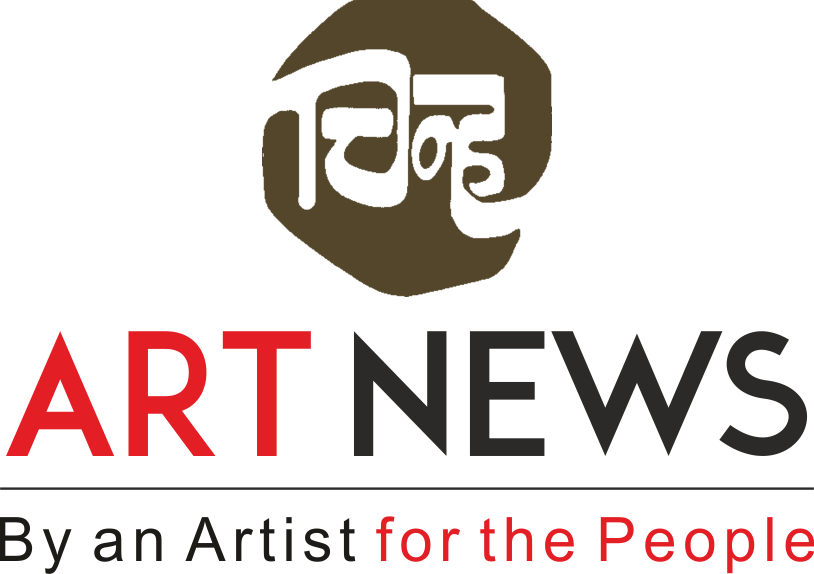No products in the cart.
- Home
- Features English
- ‘Artcheology’ unearths mysterious imagery of human experience!
‘Artcheology’ unearths mysterious imagery of human experience!
A gripping visual experience awaits art enthusiasts at the Jehangir Art Gallery in Mumbai. Rajendra Anandrao Patil, affectionately known as ‘Para’ in Mumbai’s art circles, has unveiled his latest exhibition, “Artcheology – Tools Unearthed” offering a profound journey into the depths of human experience through the prism of ancient Stone Age tools.
———
Prof Rajendra Patil, an esteemed art educator at the prestigious Sir J J School of Art and a seasoned abstract artist, brings a distinctive blend of personal expression and pedagogy to the forefront of the contemporary art scene. His dual commitment to teaching and active art practice have been instrumental in shaping young minds of his students over the past three decades.
Rajendra Patil finds inspiration in his childhood memories from a lifestyle in the agrarian rural Maharashtra. While speaking to Chinha Art News, he shared that the tools used by the agriculturists as well as by the other village craftsmen and professionals such as the carpenter, cobbler, ironsmith etc were a common sight that have been etched in his memory, making deep impressions. Even though apparently these tools were from a particular locale from his village, from a specific timeline, it forms a universal underlying layer which is the bedrock of the human civilization. Hence the abstract forms arising from these impressions represent the history of the humankind with all their shapes, curves and cutting edges.
A striking characteristic of the imagery in Rajendra Patil’s work is that it subtly expresses the deep-seated nature of the memories with the help of a vertical field of depth, while transitioning from two dimensions into three dimensions and back, at the same time. He has been successful in creating such impactful visual expression by interesting experimentation with the installation technique that he has used. The viewer is presented with a rich visual experience through a wide variety of media such as Indian ink, watercolor and acrylic paint used on handmade paper and canvas alongside terracotta and metal.
At the core of Para’s artistic philosophy lies a deep connection to the abstract, a genre he has not only embraced but also attempted to redefine through his richly experimental approach. His artistry weaves objects into a unique abstract narrative, marked by vibrant color fields that transcend mere aesthetics. His canvases assume the nature of expansive mindscapes that resonate with the viewer’s innermost experiences and reflections. Recurring themes of ‘Hope and fear’ echo throughout his pieces, reflecting the perpetual human shuffling within these fundamental facets of existence.
While his large canvases appear to be a playground of texture, form, and chromatic interplay, his terracotta works delve deeper into textural explorations while forming contemplative installations. The uniquely expressive abstract language invites viewers on a creative odyssey, where elements seem to defy gravity, endowing the works with a life beyond their physical confines. The palette, ranging from deep blues to warm earth tones, carries the essence of passage of time, simultaneously attempting to become timeless.
Beyond the canvas, Para’s sculptural works in terracotta embody a modern re-telling of the archaic relics. These three-dimensional pieces bridge the gap between history and contemporary art, inviting viewers to a multisensory interaction. The sculptures, inspired by childhood memories in agrarian rural Maharashtra, draw from the tools used by craftsmen and professionals. These tools, etched in his memory, form a universal underlying layer, the bedrock of human civilization.
Speaking to Chinha Art News, ‘Para’ highlighted the deep-seated nature of these memories expressed through a vertical field of depth. His experimentation with installation techniques creates a rich visual experience, seamlessly transitioning between two and three dimensions. Using Indian ink, watercolor, and acrylic paint on handmade paper and canvas alongside terracotta and metal, the exhibition presents a captivating array of abstract forms born from a contemplative treatment of memories.
In essence, this exhibition successfully presents captivating abstract forms that delve into universal existential questions about the human condition. Rajendra Patil’s ability to evoke deep contemplation through his art speaks to the timeless connection between creativity, tools, and the evolution of civilizations.
This captivating exhibition is a must-see for art enthusiasts, offering a unique perspective on the intersection of art and archaeology. “Artcheology – Tools Unearthed” is on display at the Jehangir Art Gallery until Monday, 25th December, 2023, inviting visitors to embark on a visual journey through the edges of ages.
— Vineel Bhurke
Related
Please login to join discussion

























